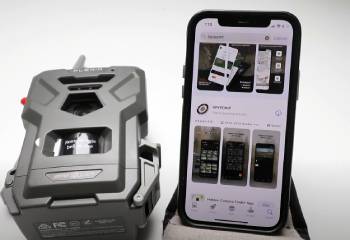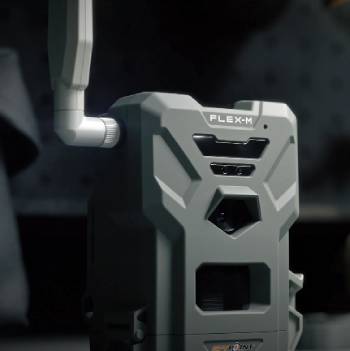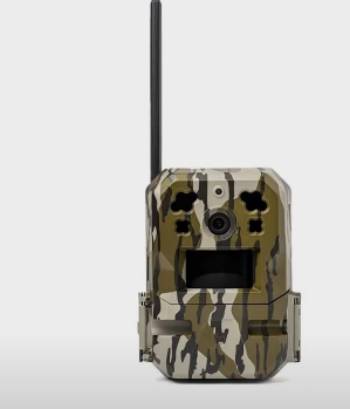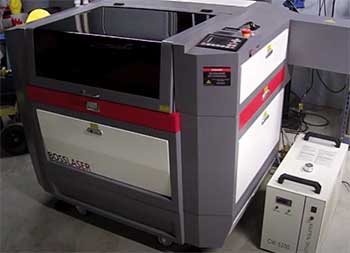I’m a bowhunter who’s spent countless hours scouting deer, and I’ve relied on cellular trail cameras to make my hunts more efficient.
SPYPOINT and Moultrie are two brands I’ve tested extensively, but which one’s right for you?
In this article, I’ll compare SPYPOINT and Moultrie based on my field experience, breaking down their features, pros, and cons to help you choose.
Whether you’re tracking bucks or securing property, I’ll share insights to guide your decision.
Let’s figure out which camera deserves your trust in the woods.
Comparison Table: SPYPOINT Vs. Moultrie
| Feature | SPYPOINT (Flex G36) | Moultrie (Mobile Edge 2.0) |
| Photo Resolution | 36 MP (interpolated) | 24 MP (interpolated) |
| Video Resolution | 1080p with sound | 1080p with sound |
| Trigger Speed | 0.27 s | 0.35 s |
| Detection Range | 100 ft | 100 ft |
| Flash Range | 100 ft | 80 ft |
| Battery Life | 1.7 months (15 pics + vids/day) | 3+ months (15 pics/day) |
| Price Range | $120-$150 | $80-$120 |
| Connectivity | Dual-SIM LTE, multi-carrier | Auto-connect LTE, AT&T/Verizon |
| Photo Plans | Free 100 pics/mo, $5-$15 plans | $4.99-$19.99/mo, unlimited option |
| Availability | Amazon, Walmart, SPYPOINT website | Amazon, Academy, Moultrie website |
My Experience with SPYPOINT and Moultrie

Last deer season, I decided to up my scouting game with cellular trail cameras on my 200-acre lease in Texas.
I’d grown tired of trekking out to check SD cards, so I grabbed a SPYPOINT Flex G36 and a Moultrie Mobile Edge 2.0 to test head-to-head.
My goal was simple: find a camera that delivered clear images, stayed powered, and didn’t break the bank with subscription fees.
Both brands promised to send photos straight to my phone, but their real-world performance told different stories.
I set the SPYPOINT Flex G36 near a feeder, using its free 100-photo plan.
Setup was quick—scanning a QR code in the SPYPOINT app took under five minutes.
Daytime photos were crisp, capturing a 10-point buck at 70 feet.
Night shots were decent, but fast-moving animals blurred.
Battery life disappointed; after six weeks of 15 photos and a few videos daily, it dropped to 15%.
False triggers from wind also ate up my photo quota fast.
The Moultrie Edge 2.0 went on a game trail, paired with a $9.99 plan for 1000 photos.
Its app was intuitive, and the camera auto-connected to Verizon’s signal despite spotty coverage.
Photos were solid, though less detailed than SPYPOINT’s at 24 MP.
Night images were clear up to 60 feet, and battery life impressed—three months in, it was still at 40%.
However, the 0.35-second trigger speed missed a sprinting coyote, and the flash range felt short.
After a season, Moultrie’s reliability won me over, but SPYPOINT’s sharper photos kept it in the race.
Key Features of SPYPOINT Flex G36

The SPYPOINT Flex G36, launched in 2023, is a cellular trail camera built for hunters who value real-time scouting.
It captures 36 MP photos (interpolated) and 1080p videos with sound, sent via dual-SIM LTE supporting AT&T, Verizon, and US Cellular.
Its 0.27-second trigger speed and 100-foot detection and flash ranges are top-notch.
The SPYPOINT app offers four modes: photo, video, time-lapse, and time-lapse+.
A free 100-photo monthly plan is included, with paid plans for HD or unlimited images.
GPS tracking and a compact design add versatility.
I appreciated its sharp images and app-driven controls, despite battery issues.
Key Features of Moultrie Mobile Edge 2.0
Moultrie’s Mobile Edge 2.0, released in 2024, prioritizes simplicity and longevity.
It delivers 24 MP photos and 1080p videos with sound, using auto-connect LTE for AT&T or Verizon.
The 0.35-second trigger speed and 100-foot detection range are solid, though the flash reaches only 80 feet.
Battery life is a standout, lasting over three months on 8 AA batteries.
The Moultrie Mobile app includes AI species recognition and activity charts.
Plans start at $4.99 for 500 photos, with unlimited options available.
Its durable build and long-lasting power made it a field favorite for me.
Pros of SPYPOINT Flex G36
- High Resolution: 36 MP photos were razor-sharp. I spotted antler details at 70 feet.
- Fast Trigger Speed: 0.27 seconds caught every deer. Even quick foxes were captured clearly.
- Long Range: 100-foot detection and flash lit up distant game. I saw bucks at 90 feet.
- Dual-SIM Connectivity: Multi-carrier support ensured signal in rural areas. It outperformed my phone.
- Free Photo Plan: 100 free photos monthly suited light use. I saved on subscriptions initially.
- GPS Tracking: Built-in GPS eased theft concerns. I felt secure leaving it remote.
- App Features: Time-lapse+ and customizable maps aided scouting. I planned better stand locations.
Cons of SPYPOINT Flex G36
/
- Poor Battery Life: 1.7 months with videos was short. I swapped batteries twice per season.
- False Triggers: Wind and shadows triggered extra shots. My photo quota vanished quickly.
- Blurry Night Videos: Fast animals blurred in low light. A nocturnal bobcat was unidentifiable.
- No Internal Viewer: App-only access frustrated me without a phone. Field checks were limited.
- Subscription Costs: HD photos cost $5-$15 monthly. I paid extra for quality images.
- Over-Sensitive Sensor: Frequent adjustments were needed. It wasted shots on brush movement.
- Battery Tray Issues: Loose clips caused minor hassles. One battery column popped out often.
Pros of Moultrie Mobile Edge 2.0

- Long Battery Life: Over three months on 8 AA batteries. I rarely worried about power.
- Affordable Plans: $4.99 for 500 photos was budget-friendly. I upgraded to unlimited for $15.
- AI Species Recognition: The app tagged deer and predators. It streamlined my photo sorting.
- Durable Build: Survived rain and hail storms. It held up in harsh weather conditions.
- Simple Setup: Auto-connect LTE was seamless. I had it running in under five minutes.
- Activity Charts: App graphs showed peak game movement. I timed hunts more effectively.
- Clear Day Photos: 24 MP images were solid for scouting. I identified does easily.
Cons of Moultrie Mobile Edge 2.0
- Slower Trigger Speed: 0.35 seconds missed fast animals. A coyote escaped capture.
- Shorter Flash Range: 80 feet limited night shots. Distant deer were dimly lit.
- Lower Resolution: 24 MP lacked SPYPOINT’s detail. Antler tines were harder to count.
- No GPS Tracking: No anti-theft feature worried me. I checked it frequently.
- Subscription Required: No free photo plan like SPYPOINT. I paid $9.99 monthly for 1000 photos.
- Night Photo Noise: Grainy images past 60 feet. I struggled to ID nocturnal game.
- Limited Carrier Options: Only AT&T or Verizon. It dropped signal in some rural spots.
Also Read: My Thoughts On Moultrie Edge Pro
Why Moultrie Edges Out for Reliability
After a season of testing, Moultrie’s Mobile Edge 2.0 became my go-to for its unbeatable battery life and affordable plans.
The SPYPOINT Flex G36’s sharper photos and faster trigger were impressive, but its battery drain and false triggers frustrated me.
Moultrie’s AI features and durable build suited my long-term scouting needs, though its lower resolution and flash range were drawbacks.
If you prioritize image clarity and range, SPYPOINT’s G36 shines, but for consistent, low-maintenance performance, Moultrie wins.
Your choice depends on your hunting style and budget—both are solid, but Moultrie felt more dependable.
Comparing Image and Video Quality
Image quality is critical for scouting, and SPYPOINT’s 36 MP photos outshone Moultrie’s 24 MP.
Daytime shots from the Flex G36 captured fine details, like a buck’s ear scar at 80 feet.
Moultrie’s photos were clear but less sharp, making distant antlers harder to discern.
At night, SPYPOINT’s 100-foot flash range beat Moultrie’s 80 feet, though both blurred fast-moving animals.
Videos were identical—1080p with sound—but SPYPOINT’s faster trigger caught more clips.
For detailed scouting, SPYPOINT’s higher resolution and range give it the edge, but Moultrie’s images are sufficient for most hunters.
Battery Life and Power Management

Battery life was a dealbreaker for me, and Moultrie dominated.
The Edge 2.0 lasted over three months on 8 AA lithium batteries, taking 15 photos daily.
SPYPOINT’s Flex G36, with videos, managed only 1.7 months, requiring frequent swaps.
I tried alkaline batteries once—both cameras died in weeks, so lithium is a must.
Moultrie’s efficiency meant fewer trips to my lease, saving time.
SPYPOINT’s $50 solar panel add-on helped, but it’s an extra cost.
Both support 12-volt external packs, but Moultrie’s out-of-box longevity makes it ideal for remote setups.
Connectivity and App Performance
Connectivity is where cellular cameras shine, and both brands delivered, with caveats.
SPYPOINT’s dual-SIM LTE auto-selected AT&T, Verizon, or US Cellular, holding signal in a valley where my phone struggled.
Moultrie’s auto-connect LTE stuck to Verizon, dropping occasionally in low-coverage areas.
SPYPOINT’s app offered time-lapse+ and map tools, but false triggers cluttered my feed.
Moultrie’s app, with AI species tagging and activity charts, streamlined scouting, though its interface felt clunkier.
SPYPOINT’s free 100-photo plan was a bonus, but Moultrie’s plans were more flexible.
For rural connectivity, SPYPOINT’s multi-carrier setup slightly outperforms.
Also Read: Comparison of Spypoint LM2 Vs. Flex
Frequently Asked Questions (FAQs)
Moultrie Mobile Edge 2.0 for battery life; SPYPOINT Flex G36 for resolution and range.
AT&T, Verizon, and US Cellular via dual-SIM LTE, auto-selecting the best signal.
Yes, they’re reliable with long battery life and affordable plans, but resolution is lower.
Moultrie Mobile Edge 2.0, lasting over three months on 8 AA batteries.
Final Thoughts
After a season in the field, Moultrie’s Mobile Edge 2.0 is my pick for its reliability and long battery life.
SPYPOINT’s Flex G36 offers sharper photos and better range, but its battery issues and false triggers held it back.
You deserve a camera that simplifies scouting, and Moultrie’s durability and affordable plans delivered for me.
If you need high-res images, go with SPYPOINT, but for hassle-free performance, choose Moultrie.
Match your camera to your hunting needs, and you’ll be set for success.

